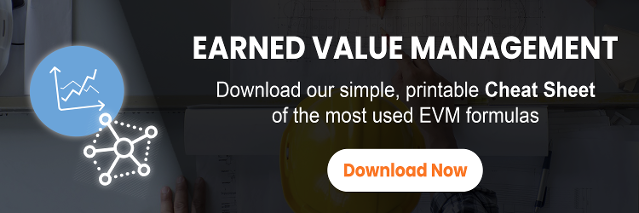As a project controls professional, one of the most important things to understand is that there are a huge number of different formulas that can make your life significantly easier on a daily basis — provided that you know when, where and how to utilize them properly.
Have you ever spent countless hours of your precious time trying to figure out if the value of the project you’re working on is equal to the amount of money you’re actually spending to complete it? With earned value management and the following terms and formulas, you’ll never have to wonder again — you’ll know beyond the shadow of a doubt.
>>> Keep Important Earned Value Management Formulas Right At Your Finger Tips <<<
Earned Value Management Formulas
Earned Value (EV)
Earned Value is a term that refers to the cost of the work that has been completed expressed as the value of the performance budget assigned to that work. It’s not just the cost of the completing some work, it representing the value that has been earned by completing the work. This is commonly also referred to in the construction industry as the “budgeted cost of work performed,” or BCWP. Earned Value is calculated as the Budget At Completion multiplied by the Percent of Work Completed.
EV = BAC x % Complete
Planned Value (PV)
This term refers to the approved budget for work that is scheduled to be completed by a certain date in the future. Whereas Earned Value takes a look at how much you spent to get work done by a certain time, Planned Value is proactive in that it looks at how much you SHOULD HAVE spent at to get to a specified date. Planned Value is also referred to as Budgeted Cost of Work Scheduled or BCWS.
To find the Planned Value at any point in the project, simply add up all your planned costs up to that point. Often, your planned costs are referenced from the project’s baseline.
Actual Cost (AC)
As its name suggests, Actual Cost is a term used to describe the amount of money that you actually spent to get a certain task done by a certain time. Many construction professionals also call this the “Actual Cost of Work Performed,” or ACWP or just AC.
Like Planned Value, Actual Cost is a cummulative value that continues to grow as the project progresses.
Budget at Completion
Budget at Completion, also called BAC, is the total amount of money that you’re expecting to spend to finish a particular task or for the entire project. You arrive at this number by taking all of the estimates that you’ve already conducted and assumptions that you’ve made about things like schedule and work required and adding them together.
Schedule Variance (SV)
Schedule Variance is a number that tracks how long you thought a task would take during planning versus how long it actually took and how that relates to the money you’re spending. To find this number, begin with the Earned Value of your task and subtract from it the Planned Value. The number you’re left with is the amount of money that delays have cost you and your team so far.
SV = EV – PV
Cost Variance (CV)
Cost Variance allows you to see the discrepancy between the amount of value that you earned on a task and the actual cost that ask required to perform. To arrive at this number, take the Earned Value and subtract it from the Actual Cost.
CV = EV – AC
Schedule Performance Index (SPI)
Schedule Performance Index allows you to take a closer look at overall schedule efficiency on a project. It answers the question “am I using my time wisely?” SPI provides an instantaneous check on schedule at any point in the project. To calculate SPI, take the Earned Value of your task or project and divide it by the Planned Value.
SPI = EV / PV
Cost Performance Index (CPI)
Cost Performance Index lets you look at not just how much money you’re spending to complete a project, but how well that money is being utilized. CPI provides an instantaneous check on cost performance at any point in the project. To find this number, take the Earned Value of your task or project and divide it by the Actual Cost.
CPI = EV / AC
Estimate at Completion (EAC)
Estimate at Completion is a handy number to know because it allows you to estimate the total cost of a task as of today, taking into account the work that you’ve already done. Take the approved budget that you have for the entire task and subtract from it the cost variance for all of the work that you’ve done to date. The number you’re left with is your EAC.
EAC = BAC / CPI
Estimate to Complete (ETC)
The Estimate to Complete is the number that describes exactly what it will take to finish a particular task, accounting for all of the work that you’ve done up to this point. There are a few different formulas you can use to estimate the effort to complete a task in terms of using Earned Value.
Estimate to Complete (ETC) Traditional Formula
If you already have calculated EAC, then ETC is easy to complete. Take the Estimate at Completion and subtract from it the Actual Costs to Date. This is the most common ETC formula used in Earned Value.
ETC = EAC – AC
However, there are a few more sophisticated ways to get a good Estimate to Complete value.
Estimate to Complete (ETC) Formula 1
Without thinking about it too much, the Estimate to Complete equals the remaining work effort. In project management, it’s not uncommon to re-estimate how much effort it will take to complete a task if we are in-progress and have completed some work already.
ETC = Remaining Work
Estimate to Complete (ETC) Formula 2
Another way to express Remaining work is in terms of what we’ve earned already. This formula assumes that, regardless of what happened up until now, we will finish the remaining work at the planned rate.
ETC = BAC – EV
Estimate to Complete (ETC) Formula 3
Since we are estimating the work to be completed, it often makes sense to take into account how we’ve performed so far. If we’ve performed well or poorly so far, there’s a strong likelihood we’ll continue that same execution of the remaining work.
Here, we take the previous formula and influence it with CPI, our cost performance to date. If CPI > 1, then our ETC value will reflect the good performance. If CPI < 1, then ETC will be skewed towards the previous poor performance to date.
ETC = (BAC – EV) / CPI
Estimate to Complete (ETC) Formula 4
This last formula is the most sophisticated since it incorporates both CPI like the previous formula, AND SPI. In the same fashion as the previous formula, we are influencing our ETC calculation by our to-date cost AND schedule performance. Here, we multiply CPI and SPI together to create a new rate that reflects the following idea:
If we’ve been executing poorly to-date, then we will likely execute the remaining work even MORE poorly. If we’ve been executing the work strongly, we will likely execute the remaining work even better. It’s almost like there’s an acceleration factor in this calculation.
ETC = (BAC – EV) / (CPI * SPI)
Get to know these core Earned Value Management formulas and keep them handy. Chances are you’ll need them soon.
Originally published Oct 2015 and updated for relavance.


